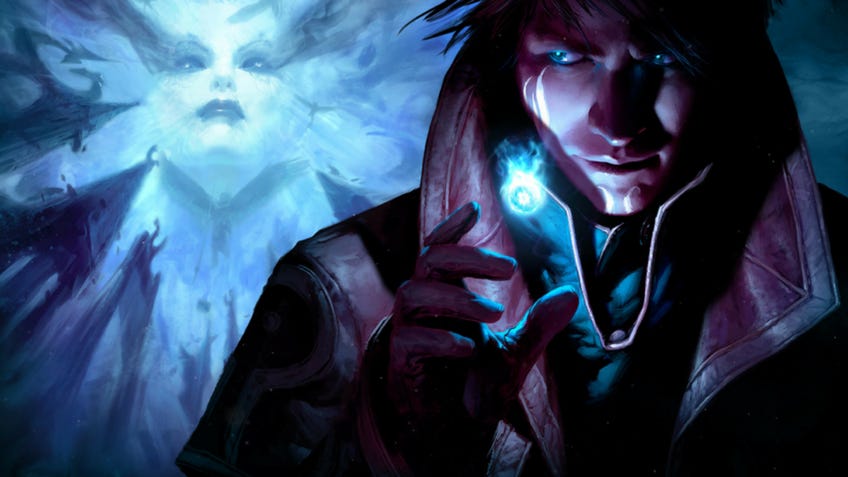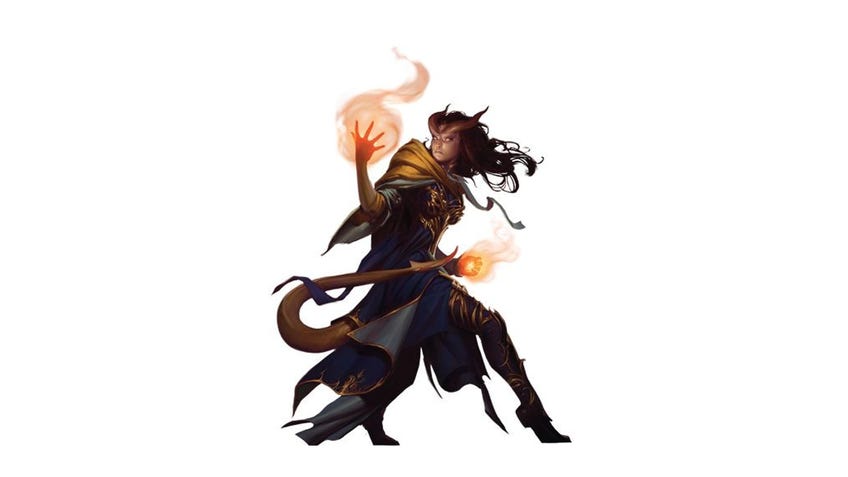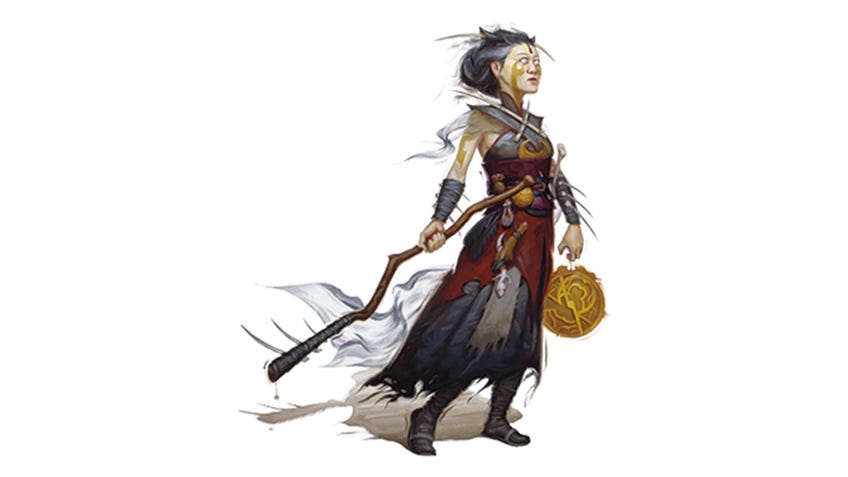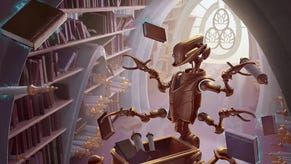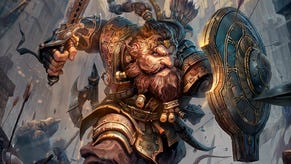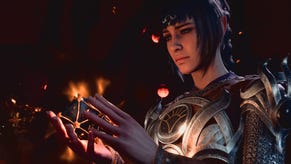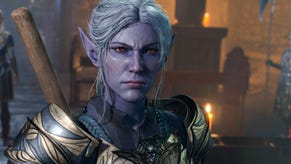Dungeons & Dragons 5E warlock class explained
How to play a patron of the dark arts.
In Dungeons & Dragons, a warlock is a dark magic user beholden to a pact with an unseemly entity. A font of dark power. And my gods, the benefits are excellent.
Perhaps you’d like to make a deal with an archfey; an ancient one who drifts inside your dreams with honeyed words and teaches you how to brutalise people’s minds with a wave of a hand.
Or a fiend, hewn of fire and madness from the Nine Hells. Something that speaks through a tiny devil, fluttering on your shoulder. They grant balls of fire, and the power to hurl people into Hell.
Or my particular favourite: the Great One. A shifting horror hidden behind the stars. This eldritch being lets you speak directly into the minds of others - among other, more forbidden things.
Warlocks aren’t even limited to being squishy magic users anymore. Take the hexblade warlock, for example: someone bonded to a sentient weapon. Members of this D&D subclass are beefy, and also delightfully cursed.
Nowadays, you don’t even need to go all edgelord to get into D&D 5E’s warlock class. Although oozing maleficence and crushing your enemies is still very much on brand.
Here, we’ll explore the different types of warlock, how to play one and, most importantly, what you need to consider when creating a warlock. Let’s get started on how to make your very own edgy magician.
How to choose a warlock patron
One of the most important aspects of creating a warlock is the relationship you have with your patron. After picking your patron, it’s good to think about why you made your pact.
Is it a pact you wanted, or were forced into? Are you fond of your patron, or do you serve under them while plotting their demise? Do they like you, or enjoy tormenting you?
What was it that drove you to your pact? Power? Curiosity? Desperation?
Also, determine what your patron demands. Some are easy-going, while others might make all sorts of horrifying requests.
Not all the reasons have to be grimdark spooky either. Perhaps you have a friendship of sorts, or they’re a literal patron of your art.
Let your DM know all about your patron - so they can prepare to play them.
What are the different warlock pacts in D&D 5E?
When you reach the third level, your patron will grant you one of three warlock boons. You can choose which one you’d like.
Pact of the Tome is good for those who want access to different types of spells. With this particular pact, your patron bestows upon you a delightful grimoire full of cantrips from other D&D classes.
Pact of the Blade lets you use your action to create a magical pact weapon. This can be anything, from a giant axe to a crossbow. You’re proficient with it - meaning you’ll hit good. As the weapon is magical, it’s handy for fighting wraiths and other spooky beasts that are impervious to physical damage.
Pact of the Chain gives you the wonderful Find Familiar spell. Other classes get access to this, but not like the warlock does. These familiars are quite special. They can do all sorts of things, from scouting on little wings, to helping you out in combat. Some of them even talk.
You can pick from an adorable pseudo dragon (a tiny dragon), imp (a tiny devil), quasit (a tiny fiend) or sprite (a tiny fey). Each beastie has unique skills. At higher levels, you can choose to see through their eyes as they travel about.
What are the different warlock patrons in D&D 5E?
The patron you make a deal with will determine all your warlock powers. Your invocations - the spells you can use without burning slots - will also be affected. Pick wisely.
The Great Old Ones - for all your eldritch nightmare needs
Ah yes, you wish to make a deal with a being outside of space, time and sanity. Some fun choices here, according to D&D sourcebook Xanathar’s Guide to Everything, include Night Serpent, Dendar ‘Eater of the World’; a pantheon of nasty slime gods; and, of course, the great Cthulhu.
Mechanically speaking, you’ll get to speak telepathically, and acquire some really horrible spells like ‘dissonant whispers’ (haunt your enemies with whispers) and ‘phantasmal force’ which lets you plant dangerous illusions in their minds.
The archfey - away with the fairies
For a creature that is both inscrutable and perhaps a little whimsical, try an archfey - essentially an immortal fairy-beast. These include actual fairy lords and creatures like night hags (sadistic witch sorts). They are often capricious and cruel. Definitely chaotic.
Less dark and inscrutable then the eldritch choice, you’ll get tons of spells that can deceive and/or charm your enemies, and ones that’ll also help you make a swift escape when needed.
The Fiend - consorting with demons
Arch devils, cambions and demons come in under the fiend umbrella. Think ‘infernal powers’ and ‘unending fire’.
As you’d expect, most of these creatures are just pure evil - straight and simple. Mechanically, this is the warlock class if you want tons of firepower - literally. You’ll get Fireball, Burning Hands and loads of other flame themed spells.
The Undying - that which is dead can never die
If you’d like an immortal patron who has somehow escaped the icy hand of death, try out an undying patron. This will not only impart a range of eerie necromantic spells like ‘speak with dead’ and ‘false life’, but also let you evade disease and, at later levels, cheat death just like your patron.
Good options for an undying patron include deathless wizards and liches respectively. You can learn all about the Undying warlock class in the Sword Coast Adventurer's Guide source book.
The Celestial - blessed might
You can play a Warlock who is bound to the Upper Planes. Meaning you’ll get your powers from the likes of unicorns and angels.
This is one of the few pacts that might inspire you to do good and, as such, it’s the only one that actually provides your warlock with traditional healing abilities. Fun if you want to be spooky, but fuzzy inside. Take a look at the Xanathar's Guide to Everything D&D sourcebook for exact details.
The Hexblade - forever bonded to a dark weapon
This is for those of you that like crushing heads, while also blasting spells. The hexblade warlock sports a sentient and definitely cursed weapon, hewn in the darkest reaches of the Shadow Fel. Odds are your sword is tied to Raven Queen, who shepherds souls across to the other side.
As a hexblade warlock, you can get all those fighting powers via the Pact of the Blade. As charisma can be used on your magic weapon instead of strength, you can also really beat the hell out of people. A fun melee class packing lots of curses. Learn more about the Hexblade warlock class in D&D sourcebook Xanathar's Guide to Everything.
How to play as a warlock in D&D 5E
A warlock is based off the CHA and CON stats. This means their spell power draws from their charisma modifier, so warlocks are charismatic individuals overall.
Just to clarify, you can be charismatic (intimidating, good at persuasion) while being totally hateable. The warlock is a great example of charisma being about personal power - not likeability.
In addition, you’ll need that constitution stat to ensure you retain concentration on spells during combat, and also to give you some extra hit points - as most warlock types can’t get substantial armour.
With most types of warlock having no fighting armour or weapon abilities, you’ll want to sit near the back and blast spells from afar.
Your spells will be weirder and crueller than the warping spells of a wizard, or a sorcerer’s mighty blasts. That said, your Eldritch Blast cantrip metes out excellent damage, is totally modifiable via invocations and stacks up as you level.
That is, of course, unless you choose to be a hexblade. In which case, you have a cursed weapon and can do things like bind the souls of people you slay. You’ll likely want to get into the fray. At higher levels these characters can mete out horrifying melee damage.
How many spell slots does a warlock have in D&D 5E?
Unlike other Dungeons & Dragons spellcasters (wizards and sorcerers) warlocks get very, very few spell slots and a handful of cantrips. You’ll start out with one spell slot. However, also unlike other spellcasters, they get all their slots back after a short rest.
One way to get past the spell slot shortage is multiclassing, which is when you level up in multiple classes. Combining a few levels in warlock with the bard or sorceror class can be particularly nasty - as these classes also pull on the CHA stat for their spells.
That said, the few slots that warlocks do have, all get cast at the highest level. They also are granted ‘invocations’, spooky spells that can be cast at will, plus special boons from their patron. So for the warlock, spell slots aren’t the only font of magic you’ll have access to.
What can warlocks do?
Warlocks can do a lot of strange things. First off, they get a range of social, destructive and area-of-effect spells as part of their pact magic. Among these, are a range of curses like hex, that can really screw with your opponents. You’ll be able to select from the general warlock spell list, and also get some particular spells based on your patron choice.
Also unique to the class, warlocks are granted invocations at level 2. These are special magic buffs that give you special abilities like permanent armour. There are many to select from, and plenty will freak your fellow party members out just as much as your enemies.
Particularly fun invocations include Mask of Many Faces, which lets you cast disguise self whenever you fancy, or Devil’s Sight, which grants you a souped up version of dark vision.
In addition, you’ll get strange abilities like telepathic talking or the ability to beguile and terrify - dependent on your patron choice - right from level 1.
Your patron will also grant you a special gift at Level 3.These include a familiar (your very own cursed slave pet), a spell book, or a magical weapon.
Eldritch Blast, the generic warlock cantrip, is also one of the most damage-heavy early cantrips in the game, and gets improved as you level up - as many cantrips do.
So, if you want to unleash fireballs and lightning - don’t play a warlock. If you want to terrify, confuse and ultimately mulch your opponents - then warlock is the class for you.
What are the best warlock races in D&D 5E?
Any race that gets charisma bonuses, such as half-elves, tieflings (half-demon folks) and aasimar (angel folks). Also, humans are, as per usual, a fantastic choice - just because they’re so versatile.
If you want to get super exotic, terrifying snake-people the Yuan-Ti are also super charismatic. Or, a changeling (a shape-shifter) also suits the deceptive, shifty nature of a warlock well. As usual, it’s best to go with the race you’re most drawn to.
How to create a D&D 5E warlock character
First things first, get your highest stats in CHA and CON. The rest, frankly, depends on your preferences. Intelligence is good if you like investigating and learning about the world around you, but dexterity is a better shout if you want to be more swift and less squishy. Wisdom too, can come in handy for perception checks and wisdom saves - which protect you against a huge range of mind-bending spells.
Strength is definitely going to be your dump stat - because even the beefy warlocks don’t need it to hit.
Next, get yourself a background that boosts your charisma skills, like Charlatan, or Noble. Cantrip-wise, definitely take Eldritch Blast to get your blast-o-matic on. In terms of first-level spells, it’s good to pick something shifty and social like Charm Person.
Should I play a warlock in D&D 5E?
This is a class for people who like learning all of strange, interplanar magic stuff in Dungeons & Dragons. People who like dark secrets and fraternising with mysterious entities. People who enjoy drama, but are less driven by the need to destroy with far-out spells (like a sorcerer), or to alter the fabric of reality itself (like a wizard).
Warlocks are perfect for schemers and/or role-players. Because of their high-charisma - Warlocks are also a good choice for a party ‘face’ (the character that deals with social stuff during adventure).
If all this appeals, let’s make a pact.
We hope you enjoyed the old Warlock 101. However, there are many other Dungeons & Dragons classes to enjoy. So, if this is not the one for you, be sure to check out our other D&D character guides. Other fun spell casters include the wizard and the sorceror, or you can combine magic and brawn as a druid, cleric or paladin.
